
Imagine zooming through cities in a levitating pod or just hovering above traffic in a drone-like structure as your daily commute times are cut in half. Does this give you a peek into how transportation could look like in the future? Well, good news, as per experts these kinds of transportation options could be available to you as early as by 2030.
One such type of transportation is hyperloop, which is an evolution of magnetic levitation. India is already in talks with several transportation companies to enable faster interstate travel. Does this excite you? Well, we are here to tell you all about magnetic levitation, hyperloop and what transportation could possibly look like in the future.
According to the definition mentioned in your Science textbooks, Maglev (derived from magnetic levitation) is a transport method that uses magnetic levitation to move vehicles without making any contact with the ground. With the help of magnetic levitation, a vehicle travels along a guideway using magnets that help create both lift and propulsion, thereby reducing friction to a great extent and allowing very high speeds.
In Maglev, the trains use the principle of magnetic repulsion. Each magnet has two poles. We are already aware that with magnets, opposite poles attract, whereas similar poles repel. This simple repulsive property of magnets is used in Maglev trains. However, in trains, instead of using permanent magnets, the principle of electromagnetism is used to create strong and large temporary magnets. When an electric current is passed through a coil of wire, a magnetic field is then generated around the coil based on Faraday’s laws.

In 1966 two Brookhaven Lab researchers, James Powell and Gordon Danby, published the first paper on superconducting maglev — the mode of transportation that uses fields generated by superconducting magnets to levitate and move trains. “A Maglev train car is just a box with magnets on the four corners,” Jesse Powell, the son of the Maglev inventor, who now works with his father, had once said. As simply as Jesse explains it, the concept of the Maglev trains are a bit more complex than that. But don’t worry, we will break it down for you here.
The magnets used in these trains are superconducting, which literally means that when they are cooled to less than 232.2 Celsius (450 degrees Fahrenheit) below zero, they are capable of generating magnetic fields up to 10 times stronger than what ordinary electromagnets can. And this is thus enough to suspend and propel a train.
As we explained before, the vehicle travels along a guideway, hence these magnetic fields interact with simple metallic loops set into the concrete walls of the Maglev guideway. The loops are created with conductive materials, such as aluminum. Thus, when a magnetic field moves past, it then creates an electric current that generates another magnetic field. In a Maglev guideway, three specific types of loops are set at specific intervals to do three different and important tasks. One creates a field that makes the train hover about five inches above the guideway. A second loop keeps the train stable horizontally.
The third set of loops is a propulsion system run by alternating current power. Here, both magnetic attraction and repulsion are used to move the train along the set guideway.
This floating magnet design creates a smooth trip for the vehicle. Even though the Maglev train can travel up to 603.5 kilometres (375 miles) per hour, a rider experiences less turbulence as compared to traditional steel wheel trains because here the only source of friction is air.
Maglev trains are literally “driven” by the powered guideway, thus at any point two trains traveling the same route cannot catch up and crash into one another because they’re all being powered to move at the same speed. Derailment is also unlikely as the further a Maglev train gets from its normal position between the guideway walls, the stronger the magnetic force pushing it back into its place becomes.
Well, this technology hasn’t been deployed in our country yet or even in the United States. However, once it does begin working, one fine day you could see yourself floating your way to your destination.

Hyperloop, as we already mentioned, is an evolution of Maglev, and it could very likely be the future of transportation in India. The Virgin Hyperloop company is currently conducting tests at two routes in India for a pilot project- the Mumbai-Pune route and the route between Bengaluru airport and the city.
The Maharashtra government had approved the pilot project between the Mumbai-Pune route, while Richard Branson, chairman of Virgin Hyperloop One, had announced plans of a hyperloop system between Pune and Navi Mumbai in February 2018. However, all such plans came to a halt due to the sudden outbreak of the COVID-19 pandemic.
Earlier in 2021, Virgin Hyperloop also announced a partnership with the Bangalore International Airport in order to conduct a viability test for the proposed route from airport to the city. If and whenever this would be launched, Virgin Hyperloop has the potential to cover the distance between Mumbai and Pune, which is around 150 kilometres in just 30 minutes or even less. How exciting does that sound? Well, we will have to wait for that to happen.
Do you also think magnetic levitation is the future of transportation? Tell us your opinion in the comments below.
Enjoyed reading this? Then visit The Learning Tree blog and check these out:
Writing has always been Shreesha’s passion, be it for imparting knowledge or expressing opinions. In her former role as a journalist, she contributed to enriching society with knowledge. Now, at BYJU’S, she has moved on to something more exciting – creating tailor-made content for students. When she is not writing, you would find her looking for new ways to engage her child.